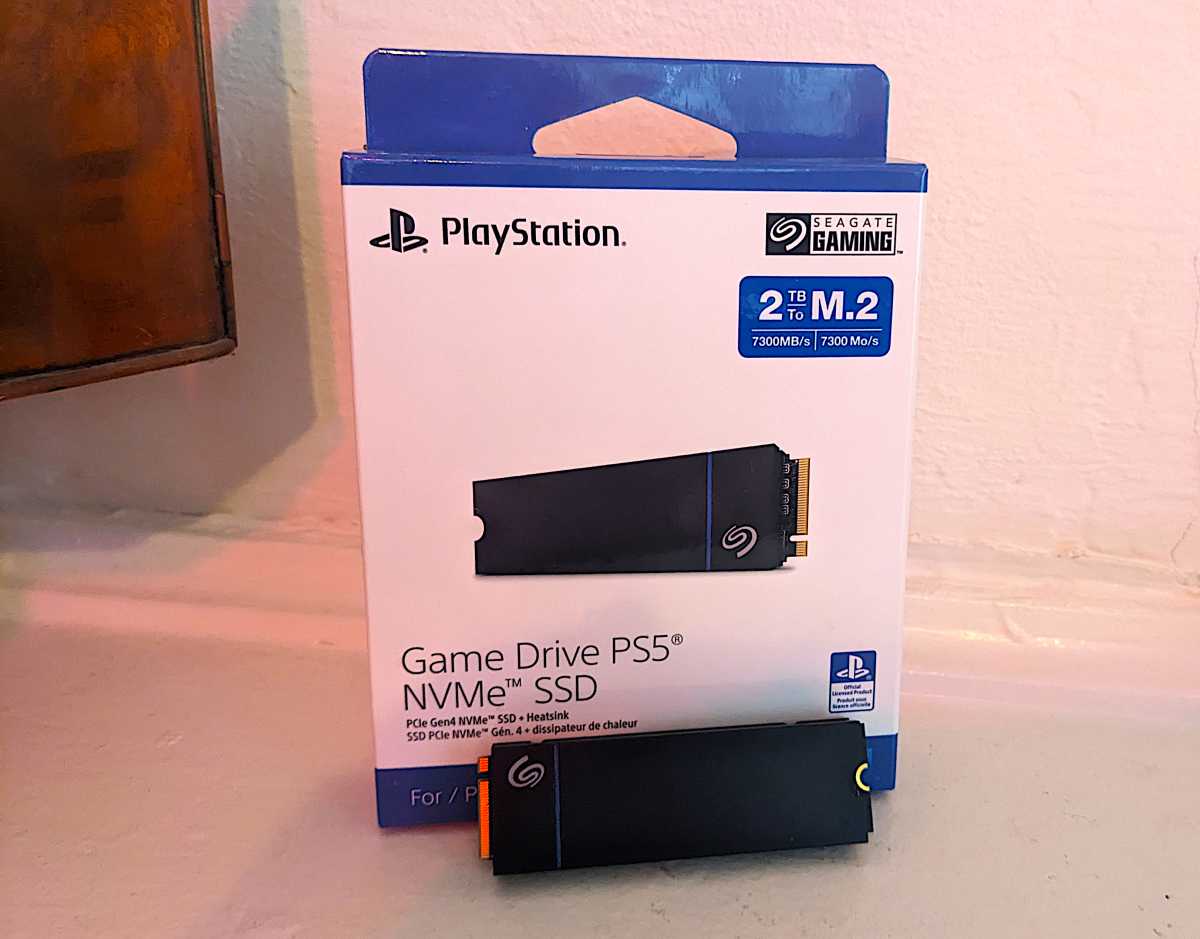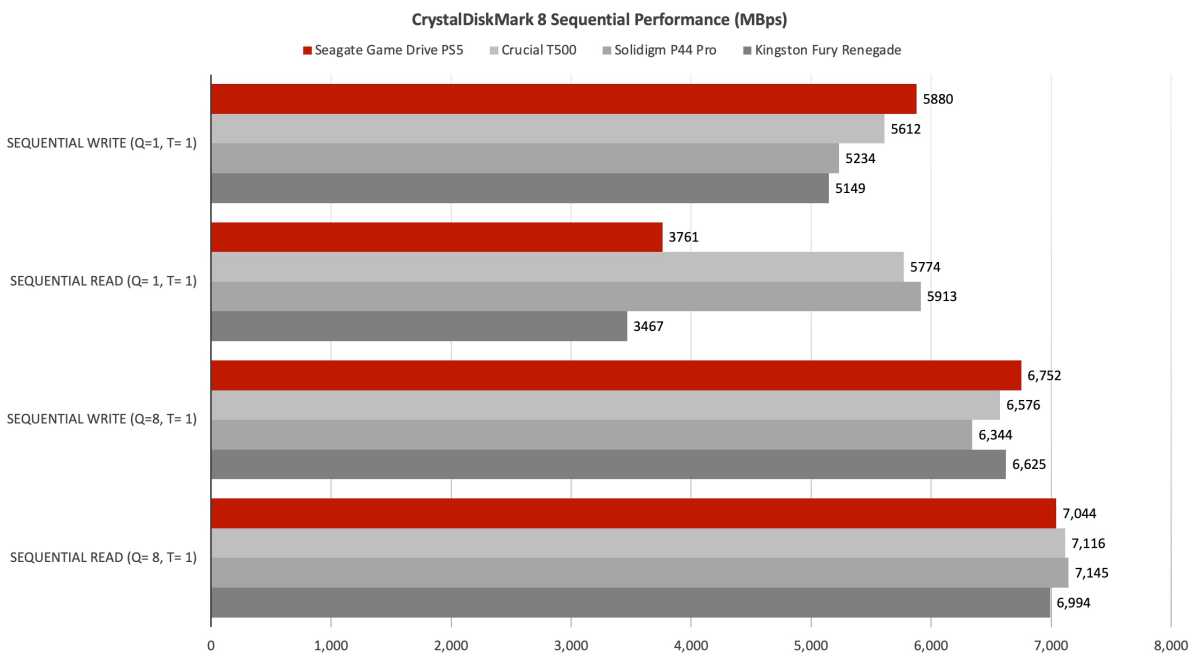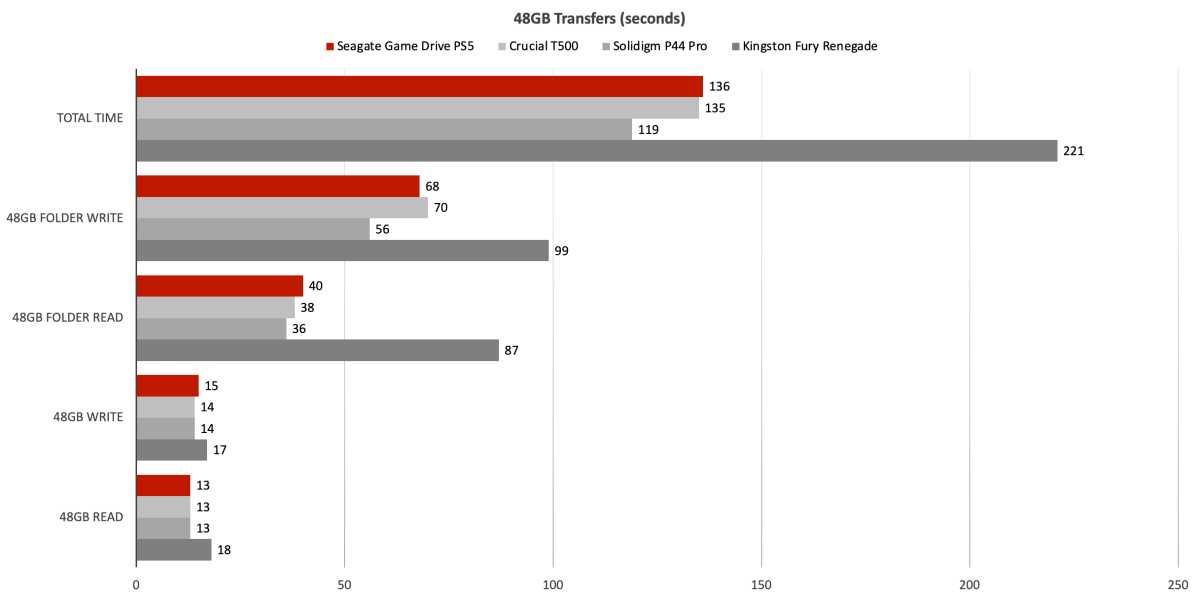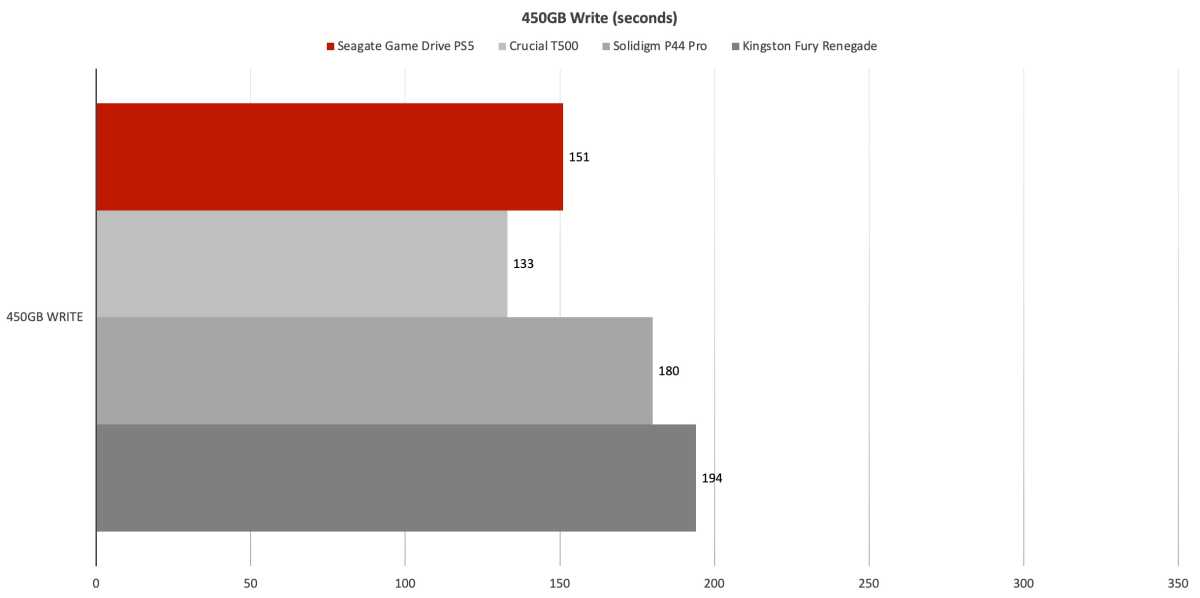 At a glance
At a glanceExpert's Rating
Pros
- Very good overall performance
- Excellent 4K performance
- Low-profile heatsink
- Twice the TBW rating of the competition
Cons
- A bit pricey
- No 4TB model
Our Verdict
The Seagate Game Drive PCIe 4.0 NVMe SSD has DRAM cache for best performance in a PS5. It’s also fast overall and sports a low-profile heatsink plus the usual fantastic Seagate longevity ratings. It’s a tad pricey, but worth the premium.
Best Prices Today: Seagate Game Drive PS5 NVMe SSD
Two things right off the bat. First, the Seagate Game Drive for PS5 is the second-fastest PCIe 4.0 NVMe SSD with random ops that we’ve tested. It’s also very fast overall.
Secondly, the Game Drive PS5 NVMe SSD features DRAM for primary caching duties. The PS5 doesn’t currently support host memory buffer (HMB), where the device apportions part of its own memory as primary cache, so for best performance, DRAM is a must.
Note, however, that DRAM-less HMB designs will still function in a PS5 (Sony doesn’t specify DRAM), just not as well under all circumstances due to their reliance upon the secondary caching (writing TLC/QLC as SLC) during writes.
Beyond DRAM however, there’s nothing PS5-specific about this SSD–any NVMe SSD with DRAM cache will function at full throttle in the PS5. Buy the Game Drive PS5 NVMe SSD because of its excellent random performance and warranty, not because it has PS5 in its name.
Further reading: See our roundup of the best PCIe 4.0 SSDs to learn about competing products.
What are the Game Drive PS5 NVMe SSD’s features?
The Game Drive PS5 NVMe SSD is a 2280 (22mm wide, 80mm long), PCIe 4.0 x4, M.2 SSD that uses 176-layer TLC NAND, a Phison PS5018-E18-41 controller, as well as the previously discussed 1GB of DRAM cache for every 1TB of storage.
The drive also sports a low-profile heatsink that sheds heat well, but still fits nicely into a PS5.

How much does the Seagate Game Drive PS5 NVMe SSD cost?
The Game Drive PS5 is available in 1TB and 2TB flavors for $100 and $150, respectively. While hardly the cheapest NVMe SSD out there, keep in mind that DRAM NVMe SSDs are pricier than HMB types. Those prices also include the heatsink, plus exceptional peace of mind, which I’ll discuss next.
What’s the warranty for the Seagate Game Drive PS5 NVMe SSD?
As usual, Seagate backs its SSD more generously than most vendors. The five-year warranty is par for the course, but the TBW (terabytes that can be written over the life of the drive) ratings are more than double the norm–1,275TBW for every 1TB of capacity. Yay, Seagate!
If you’re not familiar, TBW ratings are like the miles in an automobile warranty, mitigating the years if exceeded. Truth be told, even 600TBW (the aforementioned norm) is a heck of a lot of data. It’s extremely unlikely you’ll write more than 1,275 terabytes in 10 years, let alone five.
How fast is the Game Drive PS5 NVMe SSD?
I gave this away up top, but the Game Drive PS5 NVMe SSD offers very good performance overall, and exceptional 4K read and write performance. The latter was best of breed for a PCIe 4.0 SSD using the Windows driver. That makes it actually a better drive for running an operating system than loading games if I get down to brass tacks.
Note that the Solidigm P44 Pro using the company’s Synergy driver (not shown in the charts) was a tad faster at 4K ops–however, that driver won’t come into play with the PS5.

The Game Drive PS5 NVMe SSD (a shorter name please, Seagate!) fell off the pace in CrystalDiskMark 8’s single-queue sequential read test, finishing slightly faster than the older Kingston Fury Renegade, but well behind the newer Crucial T500 and Solidigm P44 Pro. Still, 3.7GBps is enough to load game scenes without delay. NVMe is fast, folks!

The Game Drive PS5 NVMe SSD performed decently in our real-world 48GB transfers, although these are under Windows and may not translate directly to the PS5.

The Seagate Game Drive PS5 NVMe SSD was fast, if not the head of the class in our 48GB transfer tests. Shorter bars are better.
Jon L. Jacobi
The 450GB write went very quickly, which bodes well for loading/saving games to the drive. The write pace didn’t fall off drastically, either, when we wrote till the drive was nearly full, still filling cells at a brisk 1.4GBps.

While the Game Drive PS5 NVMe SSD wasn’t fastest under all circumstances, it’s plenty fast enough and it’s unlikely you’d be able to spot the difference between it and another NVMe SSD. That said, the excellent 4K performance would make it a good PC operating system drive as well.
Should you buy the Seagate Game Drive PS5 NVMe SSD?
While pricier than a lot of NVMe SSDs, the Game Drive PS5 NVMe is an excellent choice for many applications, including, of course, the PS5. The DRAM, heatsink, and twice-normal TBW rating should ameliorate any concerns about spending a bit more.
How we test
Internal drive tests currently utilize Windows 11, 64-bit running on an X790 (PCIe 4.0/5.0) motherboard/i5-12400 CPU combo with two Kingston Fury 32GB DDR5 4800MHz modules (64GB of memory total). Both 20Gbps USB and Thunderbolt 4 are integrated to the back panel and Intel CPU/GPU graphics are used. The 48GB transfer tests utilize an ImDisk RAM disk taking up 58GB of the 64GB of total memory. The 450GB file is transferred from a Samsung 990 Pro 2TB which also runs the OS.
Each test is performed on a newly formatted and TRIM’d drive so the results are optimal. Note that in normal use, as a drive fills up, performance will decrease due to less NAND for secondary caching, as well as other factors.
Caveat: The performance numbers shown apply only to the drive we were shipped and to the capacity tested. SSD performance can and will vary by capacity due to more or fewer chips to shotgun reads/writes across and the amount of NAND available for secondary caching. Vendors also occasionally swap components. If you ever notice a large discrepancy between the performance you experience and that which we report, by all means, let us know.






